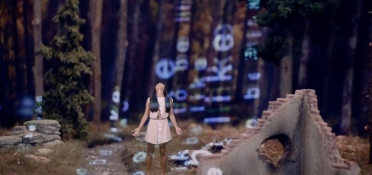The essays in this video suite ask us to consider what lies at the bottom of uncanny experiences. Why do some things feel both foreign and familiar to us?
“Space tempts me,” admits the dancer in “Territory” as she moves across a landscape made precisely for her image. Next, the word “space” begins to roll down her face and neck. “Territory” is a project by choreographer Kathleen Kelley and poet Sarah Rose Nordgren. The pair, known as “Smart Snow,” began collaborating when they were teenagers. Their first poetry video began as a diorama built with materials intended for miniature war reenactments and later expanded into an installation featuring live dancers and interactive digital texts. Through several feats of engineering, Nordgren and Kelley projected shrunken text and footage of a dancer into their diorama and filmed the two elements moving together. Across this poetry video we notice that the dancer is at once confined by, but also growing out of, this landscape, the way a child might feel inside a fenced yard, or a refrigerator box with holes cut for windows. “Territory” asks us to think about the everyday places where digital and analog rub up against one another, and can produce a type of confinement. It shows us how compressed spaces, like miniatures, ask us to consider their life-sized counterparts more carefully.
Our second video, “It’s You,” asks us to linger with the dissonance a person feels when looking at images of herself. The narrator in this video essay wants to know what she was before she was a fetus, before she was photographed, before she was a baby with “her fourth toe the Sheinbaum way—curled.” Across images of kitchens, video static, and picnic-table birthday parties, Emma Sheinbaum allows us to see a narrator witnessing her early life in a time before she knew that life was her own. Her voice insists on asking: “How can that be your dad if there he is a son? If there he is a kid making the same jokes with a different voice?” Sheinbaum holds home video footage at a second-person distance that asks her audience to watch as if these videos were cyclical, or of our own shared childhoods. “It’s You” focuses on details like the floor outside a delivery room: “Tracks of grandpa feet worn into the mauve carpet.” It’s a video that asks us what time does to selfhood, and how footage of a certain age begins to feel like a memory implanted.
In our suite’s third installment, “How to Break Out of a Mental Institution,” Mai Inna Childs’ illustrations animate a landscape of shower shoes, sporks, giant eyeballs, and herbal essences shampoo. Heather Hall’s voice narrates as if through an institutional PA system and describes a place where “they will not let you skim over things like when she died or when he unhooked your bra.” Childs’s drawings offer a humorous frame to a place that is stripped-down “like the surface of the moon.” How badly, Hall tells us, this aesthetic masks the experience of living in a sanitarium: “One: find a friend with a prescription for Klonopin. Two: Trade your medication for theirs. If this doesn’t work, resort to hand jobs. Three . . . ” This video’s visceral mark-making, paired with an understated narrative style, delivers a quiet fury that won’t get released until its final frames, when eyeballs and four-door vans surge together beneath the pink credits.
Each of the videos in this suite wants to productively unsettle us. Each prompts us to notice ourselves as watchers of another. Each asks what exactly it is that we think we don’t recognize there. Please enjoy these video investigations of the uncanny.



